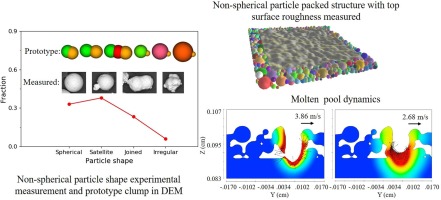当前位置:
X-MOL 学术
›
Comp. Mater. Sci.
›
论文详情
Our official English website, www.x-mol.net, welcomes your
feedback! (Note: you will need to create a separate account there.)
Numerical analysis of non-spherical particle effect on molten pool dynamics in laser-powder bed fusion additive manufacturing
Computational Materials Science ( IF 3.1 ) Pub Date : 2020-06-01 , DOI: 10.1016/j.commatsci.2020.109648 Xuesong Gao , Guilherme Abreu Faria , Wei Zhang , Kevin R. Wheeler
Computational Materials Science ( IF 3.1 ) Pub Date : 2020-06-01 , DOI: 10.1016/j.commatsci.2020.109648 Xuesong Gao , Guilherme Abreu Faria , Wei Zhang , Kevin R. Wheeler

|
Abstract In laser-powder bed fusion (L-PBF) additive manufacturing, the powder particles commonly produced by gas atomization have some non-sphericities. It is known that non-spherical particles affect the particle packing process, however, there is a limited understanding of their effect on molten pool dynamics resulted from laser-powder interaction. In this paper, the non-sphericities in L-PBF were studied by extending an existing computational framework which consisted of a particle packing model based on discrete element method (DEM) and a meso-scale molten pool model based on heat transfer and free surface flow. Experimentally, by visually inspecting the scanning electron microscope images of Inconel® alloy 718 powder particles, the non-spherical particle shapes were classified into two main types: particles with satellite and joined particles. These measured non-sphericities were simulated using a multi-sphere approach in DEM to generate the packed powder structure on a flat substrate, which was imported into the heat transfer and free surface flow model to calculate the molten pool dynamics. The calculated melt track dimensions were validated against the respective experimental data for single track melting. The effect of non-spherical particles on packing density, molten pool dynamics and melt track dimensions was discussed by comparing the simulated results for real powder with those for idealized powder consisting of spherical particles only.
中文翻译:

非球形粒子对激光-粉末床融合增材制造熔池动力学影响的数值分析
摘要 在激光-粉末床融合(L-PBF)增材制造中,通常通过气体雾化产生的粉末颗粒具有一定的非球形度。众所周知,非球形颗粒会影响颗粒堆积过程,但是,对它们对激光-粉末相互作用导致的熔池动力学的影响的理解有限。在本文中,通过扩展现有的计算框架来研究 L-PBF 的非球形,该计算框架由基于离散元方法 (DEM) 的粒子堆积模型和基于传热和自由表面的中尺度熔池模型组成。流。实验上,通过目视检查 Inconel® 718 合金粉末颗粒的扫描电子显微镜图像,非球形颗粒形状分为两种主要类型:带有卫星和连接粒子的粒子。这些测量的非球形度使用 DEM 中的多球体方法进行模拟,以在平坦基板上生成填充粉末结构,并将其导入传热和自由表面流动模型以计算熔池动力学。计算出的熔体轨道尺寸根据各自的单轨熔炼实验数据进行了验证。通过比较真实粉末与仅由球形颗粒组成的理想粉末的模拟结果,讨论了非球形颗粒对堆积密度、熔池动力学和熔体轨迹尺寸的影响。将其导入传热和自由表面流动模型以计算熔池动力学。计算出的熔体轨道尺寸根据各自的单轨熔炼实验数据进行了验证。通过比较真实粉末与仅由球形颗粒组成的理想粉末的模拟结果,讨论了非球形颗粒对堆积密度、熔池动力学和熔体轨迹尺寸的影响。将其导入传热和自由表面流动模型以计算熔池动力学。计算出的熔体轨道尺寸根据各自的单轨熔炼实验数据进行了验证。通过比较真实粉末与仅由球形颗粒组成的理想粉末的模拟结果,讨论了非球形颗粒对堆积密度、熔池动力学和熔体轨迹尺寸的影响。
更新日期:2020-06-01
中文翻译:

非球形粒子对激光-粉末床融合增材制造熔池动力学影响的数值分析
摘要 在激光-粉末床融合(L-PBF)增材制造中,通常通过气体雾化产生的粉末颗粒具有一定的非球形度。众所周知,非球形颗粒会影响颗粒堆积过程,但是,对它们对激光-粉末相互作用导致的熔池动力学的影响的理解有限。在本文中,通过扩展现有的计算框架来研究 L-PBF 的非球形,该计算框架由基于离散元方法 (DEM) 的粒子堆积模型和基于传热和自由表面的中尺度熔池模型组成。流。实验上,通过目视检查 Inconel® 718 合金粉末颗粒的扫描电子显微镜图像,非球形颗粒形状分为两种主要类型:带有卫星和连接粒子的粒子。这些测量的非球形度使用 DEM 中的多球体方法进行模拟,以在平坦基板上生成填充粉末结构,并将其导入传热和自由表面流动模型以计算熔池动力学。计算出的熔体轨道尺寸根据各自的单轨熔炼实验数据进行了验证。通过比较真实粉末与仅由球形颗粒组成的理想粉末的模拟结果,讨论了非球形颗粒对堆积密度、熔池动力学和熔体轨迹尺寸的影响。将其导入传热和自由表面流动模型以计算熔池动力学。计算出的熔体轨道尺寸根据各自的单轨熔炼实验数据进行了验证。通过比较真实粉末与仅由球形颗粒组成的理想粉末的模拟结果,讨论了非球形颗粒对堆积密度、熔池动力学和熔体轨迹尺寸的影响。将其导入传热和自由表面流动模型以计算熔池动力学。计算出的熔体轨道尺寸根据各自的单轨熔炼实验数据进行了验证。通过比较真实粉末与仅由球形颗粒组成的理想粉末的模拟结果,讨论了非球形颗粒对堆积密度、熔池动力学和熔体轨迹尺寸的影响。











































 京公网安备 11010802027423号
京公网安备 11010802027423号